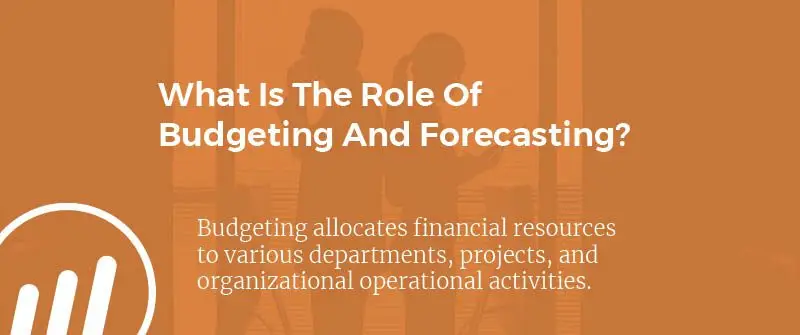What Is The Role Of Budgeting And Forecasting In Performance Management?

What Is The Role Of Budgeting And Forecasting?
In business and finance, budgeting and forecasting services are crucial components that significantly impact an organization’s short-term and long-term success. These tools help set financial expectations and play a pivotal role in guiding its strategic direction and operational efficiency.
Definition of Budgeting and Forecasting
Budgeting allocates financial resources to various departments, projects, and organizational operational activities. It involves setting spending limits and financial targets over a specified fiscal year. Meanwhile, forecasting involves predicting future financial outcomes based on historical data, current market trends, and other relevant factors. What Is Financial Forecasting? Forecasting includes analyzing historical data, trends, and market conditions and using analytical tools to estimate future outcomes. Forecasting can cover various time horizons, from short-term (monthly or quarterly) to long-term (annually or over several years).

Importance in Financial Planning
Both budgeting and forecasting are indispensable in financial forecasting. They enable businesses to set realistic financial goals, review past financial performance, and adapt to changing market conditions. By projecting future revenues and expenses, organizations can avoid financial pitfalls and position themselves to seize growth opportunities. These processes act as a financial roadmap, bringing clarity and direction to business operations. Here are budgeting and forecasting examples.
Impact on Business Decision-Making
The integration of budgeting and forecasting directly influences business decisions at all levels by allocating resources effectively. For executives, it means better-informed decisions regarding investments, expansions, and resource allocation, often supported by insights from the best HR software for startups. For department managers, it offers clear guidelines on spending, performance targets, and workforce planning. Ultimately, these processes enhance an organization’s ability to plan strategically, operate efficiently, and achieve long-term financial stability.
What Is the Role of Budgeting in Performance Management?
Budgeting: The Backbone of Performance Management
Budgeting is a critical component in performance management. A flexible, easy-to-use, and accessible budgeting and forecasting solution is essential for driving teamwork and transparency across the business and for keeping cross-functional stakeholders involved in the processes. It serves as a foundational element for setting financial targets and ensuring that companies can track and achieve their strategic goals. By establishing a comprehensive budget, businesses can allocate resources more effectively, monitor costs, and improve overall financial health.

Setting Financial Targets
How to do budget projections is one of the primary roles of budgeting in performance management is to set financial targets. These targets serve as benchmarks that provide direction and focus for the organization. By clearly defining revenue goals, expense limits, and profit margins, companies can align their actions and strategies to meet these targets. This step is crucial because it supports strategic planning initiatives by translating broad objectives into actionable goals.
Monitoring and Controlling Organizational Performance
A well-constructed budget is not just about setting targets; it’s also about monitoring and controlling organizational performance. Effective budgeting allows businesses to regularly measure actual performance against budgeted figures. This ongoing comparison helps identify variances and triggers proactive steps to address discrepancies. Consistent monitoring can prevent financial pitfalls and ensure that projects remain on time and within budget.
Aligning Resources with Strategic Goals
Budgeting also plays a pivotal role in aligning resources with the organization’s strategic goals. Proper resource allocation—be it financial, human, or time-related—is key to achieving long-term objectives. By aligning the budget with strategic priorities, companies can ensure their resources are invested in initiatives that drive growth and innovation, thus maximizing return on investment (ROI).
In conclusion, budgeting is integral to effective performance management. It encompasses setting financial targets, monitoring performance, and aligning resources with strategic goals, which is essential for maintaining financial discipline and steering the organization toward success.

How Are Strategic Planning, Budgeting, and Forecasting Used to Improve Organizational Performance?
Strategic planning, budgeting, and financial forecasting are pivotal in enhancing performance. They help to identify potential risks and opportunities that may affect the company’s financial performance. When used in unison, they create a cohesive roadmap that aligns resources and initiatives with long-term objectives and fosters an environment of agility and informed decision-making.
Integrating Strategic Objectives
At the core of strategic planning is aligning an organization’s vision, mission, and long-term goals with its day-to-day operations. By incorporating the budgeting process, an organization can allocate financial resources to support strategic initiatives. This ensures that each department or project receives the funding necessary to achieve targeted outcomes, thus driving overall organizational performance.
Enhancing Flexibility and Adaptability
Today’s business environment constantly evolves, necessitating a level of adaptability that static planning cannot provide. Forecasting allows organizations to anticipate market shifts, customer demands, and competitive pressures. By integrating forecasting with strategic planning and budgeting, organizations can pivot and reallocate resources as needed, ensuring they remain agile and responsive to changing conditions.
Optimizing Resource Allocation
The seamless integration of budgeting and forecasting within the strategic planning framework enables organizations to optimize resource allocation. This process involves identifying key performance indicators (KPIs) and metrics that will be monitored regularly. By continuously evaluating these metrics against forecasts, businesses can make necessary adjustments to resource allocation, maximizing efficiency and minimizing waste.
Moreover, this alignment boosts transparency and accountability across the organization. Performance naturally improves when everyone understands the financial implications of their actions and how they contribute to strategic goals. Milestone’s integrated solutions assist businesses in transforming strategic objectives into actionable plans, ensuring every dollar spent propels the organization toward its goals.

How Does Forecasting Play a Role in the Budgeting Process, and What Are the Main Factors to Consider When Creating Accurate Forecasts?
Forecasting is a crucial component of the budgeting process in modern business. Budgeting and forecasting or accounting software for startups plays a vital role in helping businesses plan, monitor, and analyze their financial performance and goals. It allows businesses to predict future financial conditions and outcomes based on historical data, market trends, and economic indicators. By providing a future-oriented perspective, forecasting enables companies to allocate resources more effectively and make informed financial decisions.
Influence of Forecasting on Budgeting
Forecasting directly influences the budgeting process by providing data-driven revenues, expenses, and cash flow expectations. This information is essential for creating realistic budgets that align with a company’s strategic objectives. An accurate forecast allows for setting achievable financial targets and helps identify potential shortfalls or surpluses in advance, facilitating timely strategic adjustments.
Types of Forecasting Methods
Different companies might adopt various forecasting methods depending on their specific needs. Some common methods include:
- Quantitative Forecasting: Uses historical data and statistical techniques to make predictions. Methods such as time-series analysis and regression models fall into this category.
- Qualitative Forecasting: Relies on expert opinions and market research. Techniques like the Delphi Method and market surveys are employed here.
- Hybrid Methods: Combine quantitative and qualitative approaches for a more comprehensive forecast.
Key Factors for Accurate Forecasting
Creating precise forecasts involves considering multiple key factors:
- Historical Data: Analyzing past performance data to identify trends and patterns.
- Market Trends: Keeping up-to-date with industry trends and economic indicators.
- Internal Factors: Considering internal factors such as operational efficiency, production capacity, and employee productivity.
- External Factors: Considering external factors like regulatory changes, competitive landscape, and technological advancements.
- Scenario Analysis: Developing different scenarios to anticipate various possible futures.

Challenges and Best Practices
Despite its importance, forecasting has its challenges, such as data quality issues, rapidly changing market conditions, and inherent uncertainties. Budgeting and forecasting software can help businesses plan, monitor, and analyze their financial performance and goals. To overcome these challenges, businesses should adopt best practices like continuous monitoring and updating of forecasts, leveraging advanced analytical tools, and fostering collaboration among various departments.
Make smarter business decisions with Milestone Inc. Discover how our budgeting and forecasting services can streamline your finances and boost your growth. Visit us at Milestone Inc. to find out more.
Related Content

What Is Incremental Budgeting?
Find out what incremental budgeting is and how it differs from other budgeting methods. Transform your budgeting process by partnering ...

What Is Financial Planning & Analysis?
Learn about financial planning and analysis to transform your business. Milestone combines deep financial insight with hands-on support so businesses ...

What If Analysis: Definition, Benefits, And How To Perform One
What-if analysis is a strategic decision-making tool used in financial planning to evaluate the impact of various hypothetical scenarios on ...
Stay in the know